An Assessment of the Net Fluid Balance in the Alberta Basin
Abstract
:1. Introduction
2. Materials and Methods
2.1. Subdivision of the Alberta Basin into Distinct Geology/Industrial Activity Regions
2.2. Calculation of Formation Volume Factors for Each Injection/Production Horizon in the Alberta Basin
2.3. Calculation of the Distance between the Injection/Production Horizon and the Precambrian Basement
2.4. Calculation of the Net Fluid Balance in Each Sub-Region and Stratigraphic Horizon Relative to the Precambrian Basement in the Alberta Basin
2.5. Calculation of In-Situ Formation Pressure Changes in the Alberta Basin over the Period 1960–2020
3. Results
3.1. Basin-Wide Total Stock-Tank Fluid Balance over the Period 1960–2020
3.2. Basin-Wide Total Stock-Tank Fluid Balance Trends over the Period 1960–2020 and Potential Implications
3.3. Assessment of the Net In-Situ Fluid Balance in Area AB1
3.4. Assessment of the Net In-Situ Fluid Balance in Area AB2
3.5. Assessment of the Net In-Situ Fluid Balance in Area AB3
3.6. Assessment of the Net In-Situ Fluid Balance in Area AB4
3.7. Assessment of the Net In-Situ Fluid Balance in Area AB5
3.8. Assessment of the Net In-Situ Fluid Balance in Area AB6
3.9. Assessment of the Net In-Situ Fluid Balance in Area AB7
3.10. Trends in Calculated Net In-Situ Fluid Balance within Each Area
3.11. In Situ Formation Pressure Changes in the Alberta Basin over the Period 1960–2020
4. Discussion
5. Conclusions
Author Contributions
Funding
Institutional Review Board Statement
Informed Consent Statement
Data Availability Statement
Acknowledgments
Conflicts of Interest
References
- Aven, T.; Renn, O. Improving government policy on risk: Eight key principles. Reliab. Eng. Syst. Saf. 2018, 176, 230–241. [Google Scholar] [CrossRef]
- Jones, L.M. Resilience by Design: Bringing Science to Policy Makers. Seismol. Res. Lett. 2015, 86, 294–301. [Google Scholar] [CrossRef]
- Evans, D.J. An Appraisal of Underground Gas Storage Technologies and Incidents for the Development of Risk Assessment Methodology; Health and Satefy Executive: Bootle, UK, 2008. [Google Scholar]
- Pawar, R.J.; Bromhal, G.S.; Carey, W.; Foxall, W.; Korre, A.; Ringrose, P.S.; Tucker, O.; Watson, M.N.; White, J.A. Recent advances in risk assessment and risk management of geologic CO2 storage. Int. J. Greenh. Gas Control 2015, 40, 292–311. [Google Scholar] [CrossRef] [Green Version]
- Bourne, S.; Crouch, S.; Smith, M. A risk-based framework for measurement, monitoring and verification of the Quest CCS Project, Alberta, Canada. Int. J. Greenh. Gas Control 2014, 26, 109–126. [Google Scholar] [CrossRef]
- U.S. Department of Energy. Risk Assessment Report for the FutureGen Project Environmental Impact Statement. 2006; p. 398. Available online: https://www.energy.gov/sites/prod/files/EIS-0394-DEIS-RiskAssessmentReport-2007.pdf (accessed on 16 October 2021).
- Duncan, I.J. Developing a Comprehensive Risk Assessment Framework for Geological Storage of CO2. 2014. Available online: https://www.osti.gov/servlets/purl/1170168 (accessed on 16 October 2021).
- Smith, S.A.; Sorensen, J.A.; Steadman, E.N.; Harju, J.A. Acid gas injection and monitoring at the Zama oil field in Alberta, Canada: A case study in demonstration-scale carbon dioxide sequestration. Energy Procedia 2009, 1, 1981–1988. [Google Scholar] [CrossRef] [Green Version]
- Smith, S.A.; Sorensen, J.A.; Steadman, E.N.; Harju, J.A. Plains CO2 Reduction (PCOR) Partnership (Phase II)—Zama Field Validation Test Regional Technology Implementation Plan—Task 3 Deliverable D52. 2010. Available online: https://undeerc.org/pcor/newsandpubs/pdf/SAS-D52_Zama_RTIP-Re-revised-June10FINAL.pdf (accessed on 16 October 2021).
- Shell Canada Quest Subsurface Team. Quest Storage Development Plan. 2011. Available online: https://open.alberta.ca/dataset/46ddba1a-7b86-4d7c-b8b6-8fe33a60fada/resource/5555eb2e-6d86-4419-97a3-8d3de7c5b702/download/storagedevelopmentplan.pdf (accessed on 16 October 2021).
- Jones, J.P.; Brydie, J.R.; Perkins, E.H. Investigation of potential far field impacts on freshwater resources related to CO2 storage: A case study of the HARP project site in Alberta, Canada. Energy Procedia 2013, 37, 3792–3799. [Google Scholar] [CrossRef] [Green Version]
- Soltanzadeh, M. Regional-Scale Geomechanical Characterization of the Devonian Sedimentary Succession West of the Athabasca Area in Support of Potential CO2 Storage Operations. 2014. Available online: https://albertainnovates.ca/focus-areas/clean-resources/project-library/ (accessed on 16 October 2021).
- Longworth, H.L.; Dunn, G.C.; Semchuck, M. Underground disposal of acid gas in Alberta, Canada: Regulatory concerns and case histories. Presented at the SPE Gas Technology Symposium, Calgary, AB, Canada, 28 April– 1 May 1996. [Google Scholar] [CrossRef]
- Alshuhail, A.A.; Lawton, D.C.; Isaac, H.J. Geophysical characterization of the Devonian Nisku Formation for the Wabamun Area CO2 sequestration project (WASP), Alberta, Canada. Energy Procedia 2011, 4, 4696–4703. [Google Scholar] [CrossRef] [Green Version]
- Enhance Energy and Northwest Redwater Partnership. The Alberta Carbon Trunkline and Clive Injection Facility Knowledge Sharing Report 2016. 2017. Available online: https://open.alberta.ca/dataset/f66db190-751e-4ad2-8a26-60809244a28e/resource/a94e61ab-8333-4f95-8380-a023fd12f849/download/ccsactlreport2016.pdf (accessed on 16 October 2021).
- Goodarzi, S.; Settari, A. Geomechanical Modelling and Analysis Wabamun Area CO2 Sequestration Project (WASP). 2010. Available online: https://www.ucalgary.ca/wasp/Geomechanical%20Numerical%20Modeling.pdf (accessed on 16 October 2021).
- Alberta Energy. Carbon Capture and Storage Summary Report of the Regulatory Framework Assessment. 2013. Available online: https://open.alberta.ca/dataset/5483a064-1ec8-466e-a330-19d2253e5807/resource/ecab392b-4757-4351-a157-9d5aebedecd0/download/6259895-2013-carbon-capture-storage-summary-report.pdf (accessed on 31 January 2021).
- Nakai, J.S.; Weingarten, M.; Sheehan, A.F.; Bilek, S.L.; Ge, S. A Possible Causative Mechanism of Raton Basin, New Mexico and Colorado Earthquakes Using Recent Seismicity Patterns and Pore Pressure Modeling. J. Geophys. Res. Solid Earth 2017, 122, 8051–8065. [Google Scholar] [CrossRef]
- Ogwari, P.O.; DeShon, H.R.; Hornbach, M.J. The Dallas-Fort Worth Airport Earthquake Sequence: Seismicity Beyond Injection Period. J. Geophys. Res. Solid Earth 2018, 123, 553–563. [Google Scholar] [CrossRef]
- Walters, R.J.; Zoback, M.D.; Baker, J.W.; Greg, B. Scientific Principles Affecting Protocols for Site-Characterizaion and Risk Assessment Related to the Potential for Seismicity Triggered by Saltwater Disposal and Hydraulic Fracturing. 2015, pp. 1–80. Available online: https://scits.stanford.edu/sites/g/files/sbiybj13751/f/scitsguidelines_final_spring2015_0.pdf (accessed on 16 October 2021).
- Zhou, Q.; Birkholzer, J.T. On scale and magnitude of pressure build-up induced by large-scale geologic storage of CO2. Greenh. Gases Sci. Technol. 2011, 47, 36–47. [Google Scholar] [CrossRef] [Green Version]
- Birkholzer, J.T.; Oldenburg, C.M.; Zhou, Q. CO2 migration and pressure evolution in deep saline aquifers. Int. J. Greenh. Gas Control 2015, 40, 203–220. [Google Scholar] [CrossRef] [Green Version]
- Ghaderi, S.M.; Leonenko, Y. Reservoir modeling for Wabamun lake sequestration project. Energy Sci. Eng. 2015, 3, 98–114. [Google Scholar] [CrossRef]
- Chang, K.W.; Segall, P. Injection-induced seismicity on basement faults including poroelastic stressing. J. Geophys. Res. Solid Earth 2016, 121, 2708–2726. [Google Scholar] [CrossRef] [Green Version]
- Kozłowska, M.; Brudzinski, R.; Friberg, P.; Skoumal, R.J.; Baxter, N.D.; Currie, B.S. Maturity of nearby faults influences seismic hazard from hydraulic fracturing. Proc. Natl. Acad. Sci. USA 2018, 115, E1720–E1729. [Google Scholar] [CrossRef] [PubMed] [Green Version]
- Hincks, T.; Aspinall, W.; Cooke, R.; Gernon, T. Oklahoma’ s induced seismicity strongly linked to wastewater injection depth. Science 2018, 7911, 1–46. [Google Scholar] [CrossRef] [Green Version]
- Brudzinski, M.R.; Kozłowska, M. Seismicity induced by hydraulic fracturing and wastewater disposal in the Appalachian Basin, USA: A review. Acta Geophys. 2019, 67, 351–364. [Google Scholar] [CrossRef] [Green Version]
- Rutqvist, J.; Rinaldi, A.; Cappa, F.; Jeanne, P.; Mazzoldi, A.; Urpi, L.; Guglielmi, Y.; Vilarrasa, V. Fault activation and induced seismicity in geological carbon storage—Lessons learned from recent modeling studies. J. Rock Mech. Geotech. Eng. 2016, 8, 789–804. [Google Scholar] [CrossRef]
- Dempsey, D.; Suckale, J. Physics-based forecasting of induced seismicity at Groningen gas field, The Netherlands. Geophys. Res. Lett. 2017, 44, 7773–7782. [Google Scholar] [CrossRef]
- Goebel, T.H.W.; Shirzaei, M. More Than 40 yrs of Potentially Induced Seismicity Close to the San Andreas Fault in San Ardo, Central California. Seismol. Res. Lett. 2020, 92, 187–198. [Google Scholar] [CrossRef]
- Walsh, F.R.; Zoback, M.D. Oklahoma’s recent earthquakes and saltwater disposal. Sci. Adv. 2015, 1, e1500195. [Google Scholar] [CrossRef] [Green Version]
- Walsh, F.R.; Zoback, M.D. Probabilistic assessment of potential fault slip related to injection induced earthquakes: Application to north-central Oklahoma, USA. Geology 2016, 44, 991–994. [Google Scholar] [CrossRef]
- Quinones, L.; DeShon, H.R.; Jeong, S.; Ogwari, P.; Sufri, O.; Holt, M.M.; Kwong, K.B. Tracking induced seismicity in the Fort Worth basin: A summary of the 2008–2018 north Texas earthquake study catalog. Bull. Seismol. Soc. Am. 2019, 109, 1203–1216. [Google Scholar] [CrossRef]
- Skoumal, R.J.; Brudzinski, M.R.; Currie, B.S. Proximity of Precambrian basement affects the likelihood of induced seismicity in the Appalachian, Illinois, and Williston Basins, central and eastern United States. Geosphere 2018, 14, 1365–1379. [Google Scholar] [CrossRef] [Green Version]
- Pawley, S.; Schultz, R.; Playter, T.; Corlett, H. The Geological Susceptibility of Induced Earthquakes in the Duvernay Play. Geophys. Res. Lett. 2018, 45, 1786–1793. [Google Scholar] [CrossRef]
- Goebel, T.H.W.; Brodsky, E.E. The spatial footprint of injection wells in a global compilation of induced earthquake sequences. Science 2018, 361, 899–904. [Google Scholar] [CrossRef] [Green Version]
- Scanlon, B.R.; Weingarten, M.B.; Murray, K.E.; Reedy, R.C. Managing Basin-Scale Fluid Budgets to Reduce Injection-Induced Seismicity from the Recent U.S. Shale Oil Revolution. Seismol. Res. Lett. 2018, 90, 171–182. [Google Scholar] [CrossRef]
- McGarr, A. Maximum magnitude earthquakes induced by fluid injection. J. Geophys. Res. Solid Earth 2014, 119, 1008–1019. [Google Scholar] [CrossRef]
- De Barros, L.; Cappa, F.; Guglielmi, Y.; Duboeuf, L.; Grasso, J.R. Energy of injection-induced seismicity predicted from in-situ experiments. Sci. Rep. 2019, 9, 1–11. [Google Scholar] [CrossRef]
- Mcgarr, A. Seismic Moment and Volume Change. J. Geophys. Res. B Solid Earth 1976, 81, 1487–1494. [Google Scholar] [CrossRef]
- McGarr, A.; Barbour, A.J. Wastewater Disposal and the Earthquake Sequences During 2016 Near Fairview, Pawnee, and Cushing, Oklahoma. Geophys. Res. Lett. 2017, 44, 9330–9336. [Google Scholar] [CrossRef]
- Schultz, R.; Atkinson, G.; Eaton, D.W.; Gu, Y.J.; Kao, H. Hydraulic fracturing volume is associated with induced earthquake productivity in the Duvernay play. Science 2018, 359, 304–308. [Google Scholar] [CrossRef] [PubMed] [Green Version]
- Kwiatek, G.; Saarno, T.; Ader, T.; Bluemie, F.; Bohnhoff, M.; Chendorain, M.; Dresen, G.; Heikkinen, P.; Kukkonen, I.; Leary, P.; et al. Controlling fluid-induced seismicity during a 6.1-km-deep geothermal stimulation in Finland. Sci. Adv. 2019, 5, eaav7224. [Google Scholar] [CrossRef] [Green Version]
- Oklahoma Corporation Commission. Earthquake Response Summary Recent Actions. 2017. Available online: https://paperzz.com/doc/7079096/earthquake-response-summary---oklahoma-corporation-commis (accessed on 16 October 2021).
- Hand, E. Injection wells blamed in Oklahoma earthquakes: Regulators in several states start to limit wastewater disposal to reduce risks of induced tremors. Science 2014, 345, 13–14. [Google Scholar] [CrossRef] [PubMed]
- McGarr, A.; Bekins, B.; Burkardt, N.; Dewey, J.; Earle, P.; Ellsworth, W.; Ge, S.; Hickman, S.; Holland, A.; Majer, E.; et al. Coping with earthquakes induced by fluid injection. Science 2015, 347, 830–831. [Google Scholar] [CrossRef] [PubMed]
- Langenbruch, C.; Zoback, M.D. Response to Comment on ‘How will induced seismicity in Oklahoma respond to decreased saltwater injection rates? Sci. Adv. 2017, 3, eaao2277. [Google Scholar] [CrossRef] [Green Version]
- National Academy of Sciences. Induced Seismicity Potential in Energy Technologies; National Academies Press: Washington, DC, USA, 2015. [Google Scholar] [CrossRef]
- Walters, R.J.; Zoback, M.D.; Baker, J.W.; Beroza, G.C. Characterizing and Responding to Seismic Risk Associated with Earthquakes Potentially Triggered by Fluid Disposal and Hydraulic Fracturing. Seismol. Res. Lett. 2015, 86, 1110–1118. [Google Scholar] [CrossRef]
- Teare, M.; Miller, S.; Overland, S.; Marsh, R.; Tamblyn, C. ST98-2015: Alberta’s Energy Reserves 2014 and Supply/Demand Outlook 2015–2024. 2015. Available online: https://static.aer.ca/prd/documents/sts/ST98/ST98-2015.pdf (accessed on 16 October 2021).
- Mansell, R.; Moore, M.; Winter, J.; Krzepkowski, M. Size, Role and Performance in the Oil and Gas Sector. SPP Res. Pap. 2012, 5, 1–77. [Google Scholar] [CrossRef] [Green Version]
- Alberta Energy Regulator. ST98 Alberta Energy Outlook. 2020. Available online: https://www.aer.ca/providing-information/data-and-reports/statistical-reports/st98/executive-summary/data (accessed on 7 April 2021).
- Connolly, C.A.; Walter, L.M.; Baadsgaard, H.; Longstaffe, F.J. Origin and evolution of formation waters, Alberta Basin, Western Canada Sedimentary Basin. Appl. Geochem. 1990, 5, 375–395. [Google Scholar] [CrossRef] [Green Version]
- Cox, R.J. Subsurface disposal of produced waters: An Alberta perspective. In Produced Water. Technological/Environmental Issues and Solutions; Ray, J.P., Engelhardt, F.R., Eds.; Springer Science & Business Media: New York, NY, USA, 1992; Volume 46, pp. 1–606. [Google Scholar]
- The National Academies Press. Flowback and Produced Waters: Opportunities and Challenges for Innovation. 2017. Available online: https://www.nap.edu/catalog/24620/flowback-and-produced-waters-opportunities-and-challenges-for-innovation-proceedings (accessed on 16 October 2021).
- Gaurina-Međimurec, N.; Pašić, B.; Mijić, P.; Medved, I. Deep underground injection of waste from drilling activities—An overview. Minerals 2020, 10, 303. [Google Scholar] [CrossRef] [Green Version]
- Gosselin, P.; Hrudley, S.E.; Naeth, M.A.; Plourde, A.; Therrien, R.; Van Der Kraak, G.; Xu, Z. The Royal Society of Canada Expert Panel: Environmental and Health Impacts of Canada’s Oil Sands Industry. 2010. Available online: http://www.chuq.qc.ca/oms/pdf/ResponseRSCPanelTimoney.pdf (accessed on 16 October 2021).
- Jasechko, S.; Gibson, J.J.; Jean Birks, S.; Yi, Y. Quantifying saline groundwater seepage to surface waters in the Athabasca oil sands region. Appl. Geochem. 2012, 27, 2068–2076. [Google Scholar] [CrossRef]
- Burruss, R.C. Development of a Probabilistic Assessment Methodology for Evaluation of Carbon Dioxide Storage—USGS Open File Report 2009–1035. 2009. Available online: http://www.usgs.gov/pubprod (accessed on 16 October 2021).
- Schuenemeyer, J. Methodology for the 2005 USGS Assessment of Undiscovered Oil and Gas Resources, Central North Slope, Alaska. 2005. Available online: http://pubs.usgs.gov/of/2005/1410/ (accessed on 16 October 2021).
- Verma, M.K.; Bird, K.J. Role of reservoir engineering in the assessment of undiscovered oil and gas resources in the National Petroleum Reserve, Alaska. Am. Assoc. Pet. Geol. Bull. 2005, 89, 1091–1111. [Google Scholar] [CrossRef]
- Zhou, S.; Huang, H.; Liu, Y. Biodegradation and origin of oil sands in the western Canada sedimentary basin. Pet. Sci. 2008, 5, 87–94. [Google Scholar] [CrossRef] [Green Version]
- Osif, T.L. Effects of Salt, Gas, Temperature, and Pressure on the Compressibility of Water. SPE Reserv. Eng. 1988, 30, 175–181. [Google Scholar] [CrossRef]
- Pană, D.I. Precambrian Basement of the Western Canada Sedimentary Basin in Northern Alberta. 2002. Available online: https://static.ags.aer.ca/files/document/ESR/ESR_2002_02.pdf (accessed on 16 October 2021).
- Province of Alberta. Oil and Gas Conservation Act: Revised Statutes of Alberta 2000 Chapter O-6. In Queen’s Printer; Edmonton, AB, Canada, 2009; pp. 1–88. Available online: https://www.qp.alberta.ca/documents/Acts/O06.pdf (accessed on 16 October 2021).
- Alberta Energy Regulator. ST103—Field/Pool List. 2021. Available online: https://www.aer.ca/providing-information/data-and-reports/statistical-reports/st103 (accessed on 16 October 2021).
- Creaney, S.; Allan, J.; Cole, K.S.; Fowler, M.G.; Brooks, P.W.; Osadetz, K.; Macqueen, R.W.; Snowdon, L.R.; Riediger, C.L. Chapter 31—Petroleum Generation and Migration in the Western Canada Sedimentary Basin. Geol. Atlas West. Can. Sediment. Basin 1994, 50, 189–202. [Google Scholar]
- Alberta Energy Regulator. Directive 065: Resources Applications for Oil and Gas Reservoirs. In Alberta Energy Regulator; Calgary, AB, Canada, 2016; Available online: https://www.aer.ca/documents/directives/Directive065.pdf (accessed on 16 October 2021).
- House of Commons of Canada. Bill C-12: An Act Respecting Transparency and Accountability in Canada’s Efforts to Acheive Net-Zero Greenhouse Gas Emissions by the Year 2050. 2020, p. 16. Available online: https://www.parl.ca/DocumentViewer/en/43-2/bill/C-12/royal-assent (accessed on 16 October 2021).
- Canada Energy Regulator. Canada Energy Future 2020. 2020. Available online: https://www.cer-rec.gc.ca/en/data-analysis/canada-energy-future/2020/index.html (accessed on 16 October 2021).
- Energy Resources Conservation Board. Directive 51: Injection and Disposal Wells Well Classifications Completion, Logging and Testing Requirements. 1994. Available online: https://www.aer.ca/documents/directives/Directive051.pdf (accessed on 16 October 2021).
- Environment and Climate Change Canada. National Inventory Report 1990–2017: Greenhouse Gas Sources and Sinks in Canada. 2019. Available online: https://www.canada.ca/en/environment-climate-change/services/climate-change/greenhouse-gas-emissions.html (accessed on 16 October 2021).
- Layzell, D.B.; Young, C.; Lof, J.; Leary, J.; Sit, S. Towards net-zero energy systems in Canada: A key role for hydrogen. Transit. Accel. Rep. 2020, 2, 53. Available online: https://www.cesarnet.ca/publications/transition-accelerator-reports/towards-net-zero-energy-systems-canada-key-role-hydrogen%0Ahttps://transitionaccelerator.ca/towards-net-zero-energy-systems-in-canada-a-key-role-for-hydrogen (accessed on 16 October 2021).
- Banks, J.; Harris, N.B. Geothermal potential of Foreland Basins: A case study from the Western Canadian Sedimentary Basin. Geothermics 2018, 76, 74–92. [Google Scholar] [CrossRef]
- Hawkes, C.D.; McLellan, P.J.; Zimmer, U.; Bachu, S. Geomechanical factors affecting geological storage of CO2 in depleted oil and gas reservoirs. In Proceedings of the Canadian International Petroleum Conference, Calgary, AB, Canada, 8–10 June 2004. [Google Scholar] [CrossRef]
- Schwab, D.R.; Bidgoli, T.S.; Taylor, M.H. Characterizing the Potential for Injection-Induced Fault Reactivation Through Subsurface Structural Mapping and Stress Field Analysis, Wellington Field, Sumner County, Kansas. J. Geophys. Res. Solid Earth 2017, 122, 10,132–10,154. [Google Scholar] [CrossRef] [Green Version]
- Hannis, S.; Lu, J.; Chadwick, A.; Hovorka, S.; Kirk, K.; Romanak, K.; Pearce, J. CO2 Storage in Depleted or Depleting Oil and Gas Fields: What can We Learn from Existing Projects? Energy Procedia 2016, 114, 5680–5690. [Google Scholar] [CrossRef]
- Watson, T.L. Abandoned wells create liability for future subsurface exploitation. Alta. Law Rev. 2020, 57, 1001–1024. Available online: https://www.albertalawreview.com/index.php/ALR/article/view/2602/2564 (accessed on 16 October 2021). [CrossRef]
- Birks, S.J.; Fennell, J.W.; Gibson, J.J.; Yi, Y.; Moncur, M.C.; Brewster, M. Using regional datasets of isotope geochemistry to resolve complex groundwater flow and formation connectivity in northeastern Alberta, Canada. Appl. Geochem. 2019, 101, 140–159. [Google Scholar] [CrossRef]
- Bachu, S. Flow systems in the Alberta Basin: Patterns, types and driving mechanisms. Bull. Can. Pet. Geol. 1999, 47, 455–474. [Google Scholar]
- Ferguson, G.; McIntosh, J.C.; Grasby, S.E.; Hendry, M.J.; Jasechko, S.; Lindsay, M.B.J.; Luijendijk, E. The Persistence of Brines in Sedimentary Basins. Geophys. Res. Lett. 2018, 45, 4851–4858. [Google Scholar] [CrossRef]
- Zoback, M.D.; Gorelick, S.M. Earthquake triggering and large-scale geologic storage of carbon dioxide. Proc. Natl. Acad. Sci. USA 2012, 109, 10164–10168. [Google Scholar] [CrossRef] [Green Version]
- Lippmann, M.J.; Benson, S.M. Relevance of Underground Natural Gas Storage to Geologic Sequestration of Carbon Dioxide. 2002. Available online: http://escholarship.org/uc/item/5gs5q111.pdf (accessed on 16 October 2021).
- Nicot, J.; Chowdhury, A.H. Are Depleted Oil and Gas Fields a Good Alternative for the Disposal of Concentrate from Brackish Water Desalination Plants: Ca? Desalination 2005, 181, 61–74. [Google Scholar] [CrossRef]
- Benson, S.; Cook, P. Chapter 5: Underground geological storage. In IPCC Special Report on Carbon Dioxide Capture and Storage, Intergovernmental Panel on Climate Change; Cambridge University Press: New York, NY, USA, 2005; pp. 195–276. [Google Scholar]
- Perry, K.F. Natural Gas Storage Industry Experience and Technology: Potential Application to CO2 Geological Storage. Carbon Dioxide Capture Storage Deep Geol. Form. 2005, 2, 815–825. [Google Scholar] [CrossRef]
- Stern, V.H.; Schultz, R.J.; Shen, L.; Gu, Y.J.; Eaton, D.W. Alberta earthquake catalogue, version 1.0: September 2006 through December 2010. Alta. Geol. Surv. Open File Rept 2013, 15, 36. [Google Scholar]
- Fereidoni, A.; Cui, L. Composite Alberta Seismicity Catalog: CASC2014-x. 2015. Available online: http://www.inducedseismicity.ca/wp-content/uploads/2015/01/Composite-Alberta-Seismicity-Catalog3.pdf (accessed on 8 April 2021).
- Schultz, R.; Stern, V.; Gu, Y.J.; Eaton, D. Detection threshold and location resolution of the Alberta Geological Survey earthquake catalogue. Seismol. Res. Lett. 2015, 86, 385–397. [Google Scholar] [CrossRef]
- Milne, W.G. The Snipe Lake, Alberta earthquake of 8 March 1970. Can. J. Earth Sci. 1970, 7, 1564–1567. [Google Scholar] [CrossRef]
- Milne, W.G.; Berry, W. Induced Seismicity in Canada. Int. J. Rock Mech. Min. Sci. 1976, 13, 258–283. [Google Scholar] [CrossRef]
- Wetmiller, R.J. Earthquakes near Rocky Mountain House, Alberta, and their relationship to gas production facilities (Canada). Can. J. Earth Sci. 1986, 23, 172–181. [Google Scholar] [CrossRef]
- Schultz, R.; Stern, V.; Gu, Y.J. An investigation of seismicity clustered near the Cordel Field, west central Alberta, and its relation to a nearby disposal well. J. Geophys. Res. Solid Earth 2014, 119, 3410–3423. [Google Scholar] [CrossRef]
- Rokosh, C.D.; Lyster, S.; Anderson, S.D.A.; Beaton, A.P.; Berhane, H.; Brazzoni, T.; Chen, D.; Cheng, Y.; Mack, T.; Pana, C.; et al. Summary of Alberta’s Shale- and Siltstone-Hosted Hydrocarbon Resource Potential. 2012. Available online: https://ags.aer.ca/publication/ofr-2012-06 (accessed on 16 October 2021).
- Galloway, E.; Hauck, T.; Corlett, H.; Pana, D.; Schultz, R. Faults and associated karst collapse suggest conduits for fluid flow that influence hydraulic fracturing-induced seismicity. Proc. Natl. Acad. Sci. USA 2018, 115, E10003–E10012. [Google Scholar] [CrossRef] [Green Version]
- Schultz, R.; Wang, R.; Gu, Y.J.; Haug, K.; Atkinson, G. A seismological overview of the induced earthquakes in the Duvernay play near Fox Creek, Alberta. J. Geophys. Res. Solid Earth 2017, 122, 492–505. [Google Scholar] [CrossRef]
- Atkinson, G.M. Strategies to prevent damage to critical infrastructure due to induced seismicity. Facets 2017, 2, 374–394. [Google Scholar] [CrossRef]
- Peck, W.D.; Bachu, S.; Knudsen, D.J.; Hauck, T.; Crotty, C.M.; Gorecki, J.A.; Sorenson, J.; Peterson, J.; Melnik, A. CO2 storage resource potential of the Cambro-Ordovician Saline System in the western interior of North America. Energy Procedia 2013, 37, 5230–5239. [Google Scholar] [CrossRef] [Green Version]
- Bachu, S.; Melnik, A.; Bistran, R. Approach to evaluating the CO2 storage capacity in Devonian deep saline aquifers for emissions from oil sands operations in the Athabasca area, Canada. Energy Procedia 2014, 63, 5093–5102. [Google Scholar] [CrossRef] [Green Version]
- Barson, D.; Bachu, S.; Esslinger, P. Flow systems inf the Mannville Group in the east-central Athabasca area and implications for steam-assisted gravity drainage operations for in-situ bitumen production. Bull. Can. Pet. Geol. 2001, 49, 376–392. [Google Scholar] [CrossRef]
- Miall, A.D. Geoscience of climate and energy 13. The environmental hydrogeology of the oil sands, lower Athabasca area, Alberta. Geosci. Canada 2013, 40, 215–233. [Google Scholar] [CrossRef]
- Broughton, P.L. Subglacial blowouts in western Canada: Insights into extreme meltwater pressures and hydrofracturing. Boreas 2018, 47, 326–346. [Google Scholar] [CrossRef] [Green Version]
- Sperling, T. Risk-Cost-Benefit Framework for the Design of Dewatering Systems in Open Pit Mines. Ph.D. Thesis, University of British Columbia, Vancouver, BC, Canada, 1990. Available online: https://open.library.ubc.ca/soa/cIRcle/collections/ubctheses/831/items/1.0052413 (accessed on 10 January 2022).
- Walters, D.A.; Settari, A.; Kry, P.R. Coupled geomechanical and reservoir modeling investigating poroelastic effects of cyclic steam stimulation in the cold lake reservoir. SPE Reserv. Eval. Eng. 2002, 5, 507–516. [Google Scholar] [CrossRef]
- Pooladi-Darvish, M.; Mattar, L. SAGD operations in the presence of overlying gas cap and water layer—Effect of shale layers. J. Can. Pet. Technol. 2002, 41, 40–50. [Google Scholar] [CrossRef]
- Bachu, S. Synthesis and model of formation-water flow, Alberta Basin, Canada. Am. Assoc. Pet. Geol. Bull. 1995, 79, 1159–1178. [Google Scholar] [CrossRef]
- Majorowicz, J.; Hofmann, H.; Babadagli, T. Deep geothermal heat storage under oilsands—Can we use it to help oilsands industry? New EGS concept proposed. Trans. Geotherm. Resour. Counc. 2013, 37, 173–178. [Google Scholar]
- Bachu, S.; Burwash, R.A. Regional Scale Analysis of the Geothermal Regime in the Western Canadian Sedimentary Basin. Geothermics 1991, 22, 387–407. [Google Scholar] [CrossRef]
- Klassen, J. AER/AGS Open File Report 2020-05: First-Order Groundwater Availability Assessment for the Lower Athabasca Region, Eastern Alberta. 2021. Available online: https://static.ags.aer.ca/files/document/OFR/OFR_2020_05.pdf (accessed on 10 January 2022).
- Birkholzer, J.T.; Zhou, Q. Basin-scale hydrogeologic impacts of CO2 storage: Capacity and regulatory implications. Int. J. Greenh. Gas Control 2009, 3, 745–756. [Google Scholar] [CrossRef]
- Anfort, S.J.; Bachu, S.; Bentley, L.R. Regional-scale hydrogeology of the upper devonian-lower creataceous sedimentary succession, south-central Alberta basin, Canada. Am. Assoc. Pet. Geol. Bull. 2001, 85, 637–660. [Google Scholar] [CrossRef]
- Hitchon, B.; Holter, M.E. Calcium and Magnesium in Alberta Brines. Econ. Geol. Rep. 1971, 1, 1–26. Available online: https://ags.aer.ca/publications/ECO_1.html (accessed on 10 January 2022).
- TNO. TNO Report TNO-034-UT-2009-01427: Long Term Integrity of CO2 Storage—Well Abandonment. 2009. Available online: https://www.globalccsinstitute.com/archive/hub/publications/98891/long-term-integrity-co2-storage-well-abandonment.pdf (accessed on 16 October 2021).
- Allan Gray, D.; Majorowicz, J.; Unsworth, M. Investigation of the geothermal state of sedimentary basins using oil industry thermal data: Case study from Northern Alberta exhibiting the need to systematically remove biased data. J. Geophys. Eng. 2012, 9, 534–548. [Google Scholar] [CrossRef]
- Alberta Energy Regulator. Directive 040: Pressure and Deliverability Testing Oil and Gas Wells. 2020. Available online: https://static.aer.ca/prd/documents/directives/Directive040.pdf (accessed on 10 January 2022).
- Anderson, S.T.; Jahediesfanjani, H. Estimating the pressure-limited dynamic capacity and costs of basin-scale CO2 storage in a saline formation. Int. J. Greenh. Gas Control 2019, 88, 156–167. [Google Scholar] [CrossRef]
- Thibeau, S.; Bachu, S.; Birkholzer, J.; Holloway, S.; Neele, F.; Zhou, Q. Using pressure and volumetric approaches to estimate CO2 storage capacity in deep saline aquifers. Energy Procedia 2014, 63, 5294–5304. [Google Scholar] [CrossRef] [Green Version]

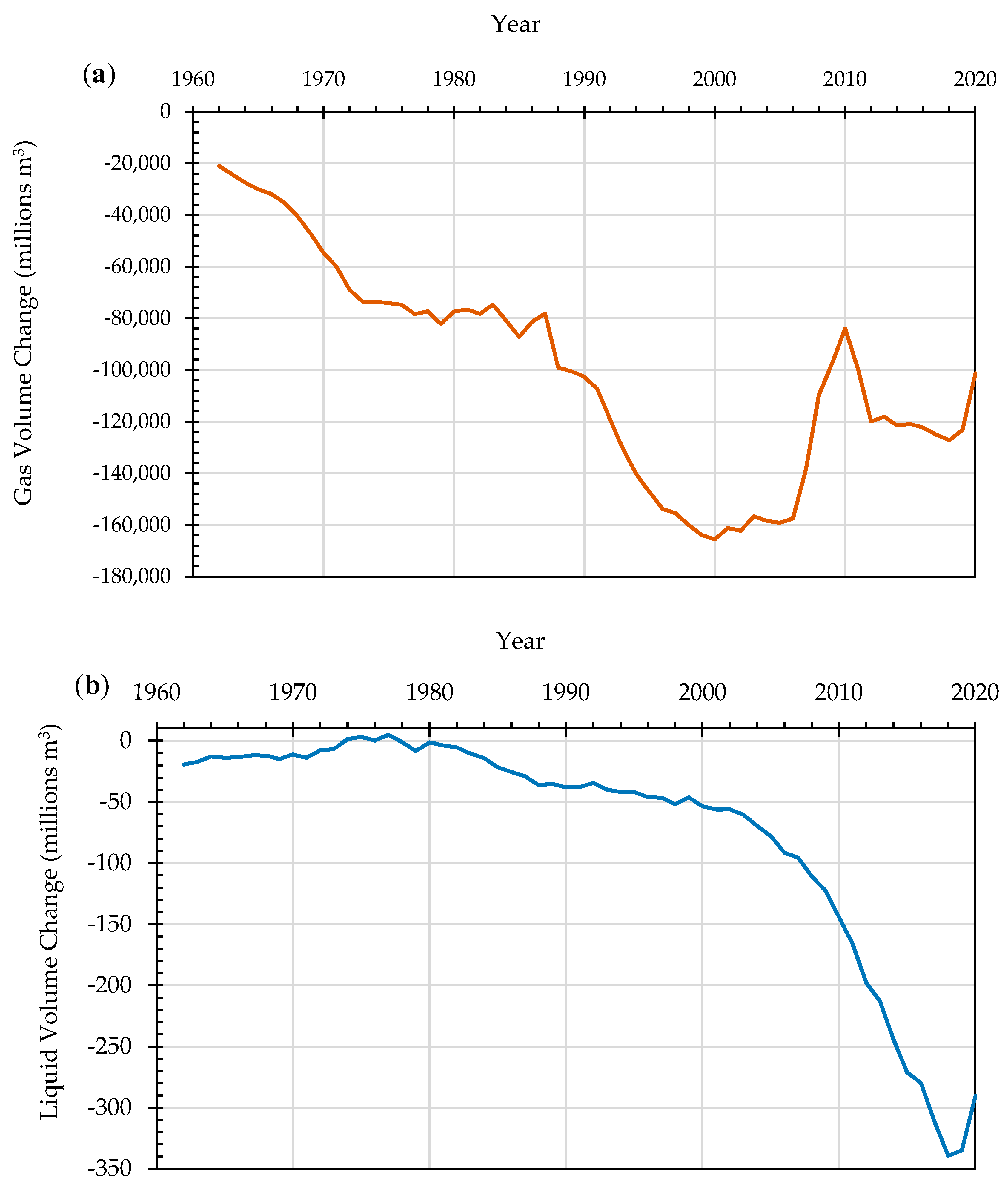
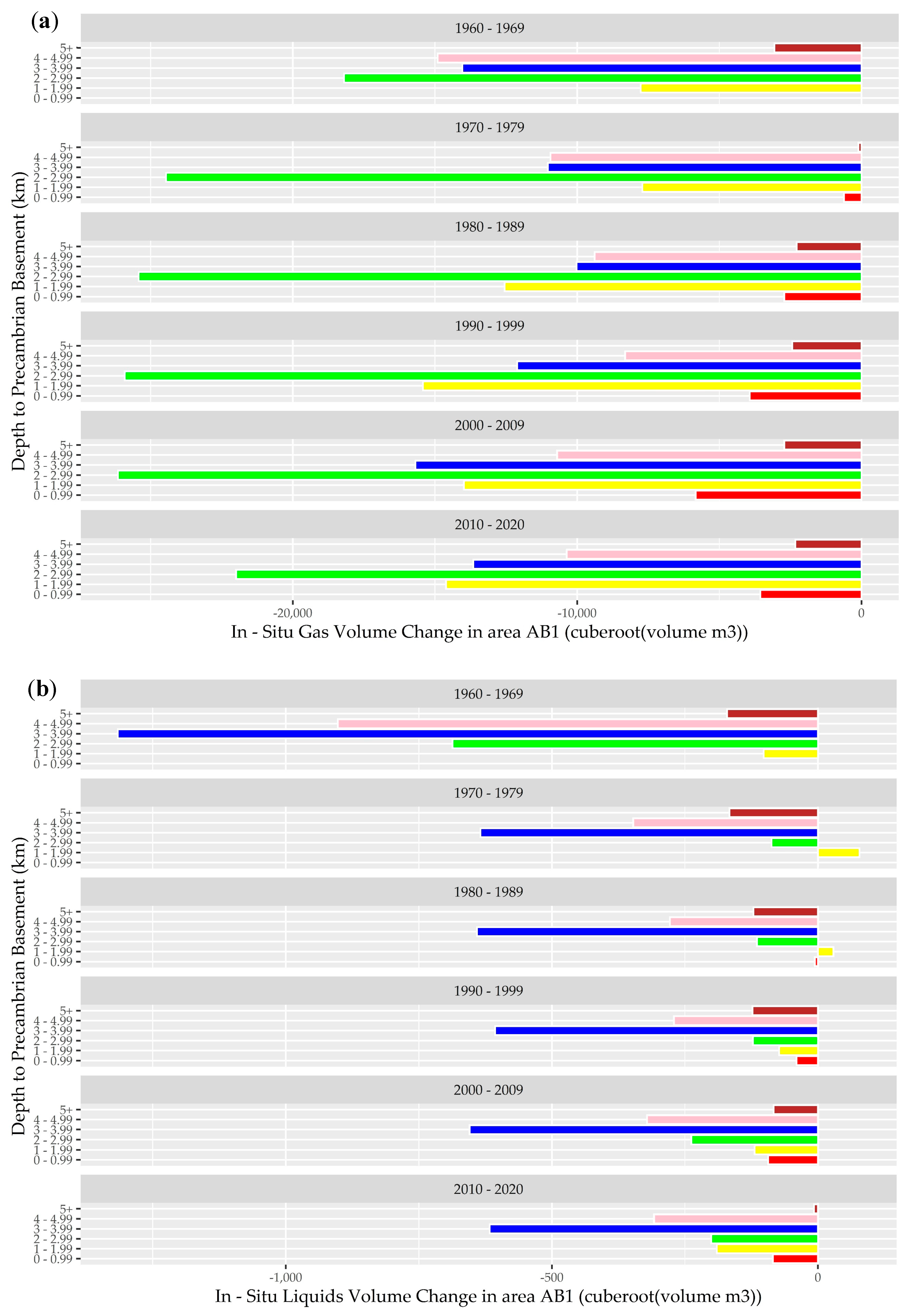

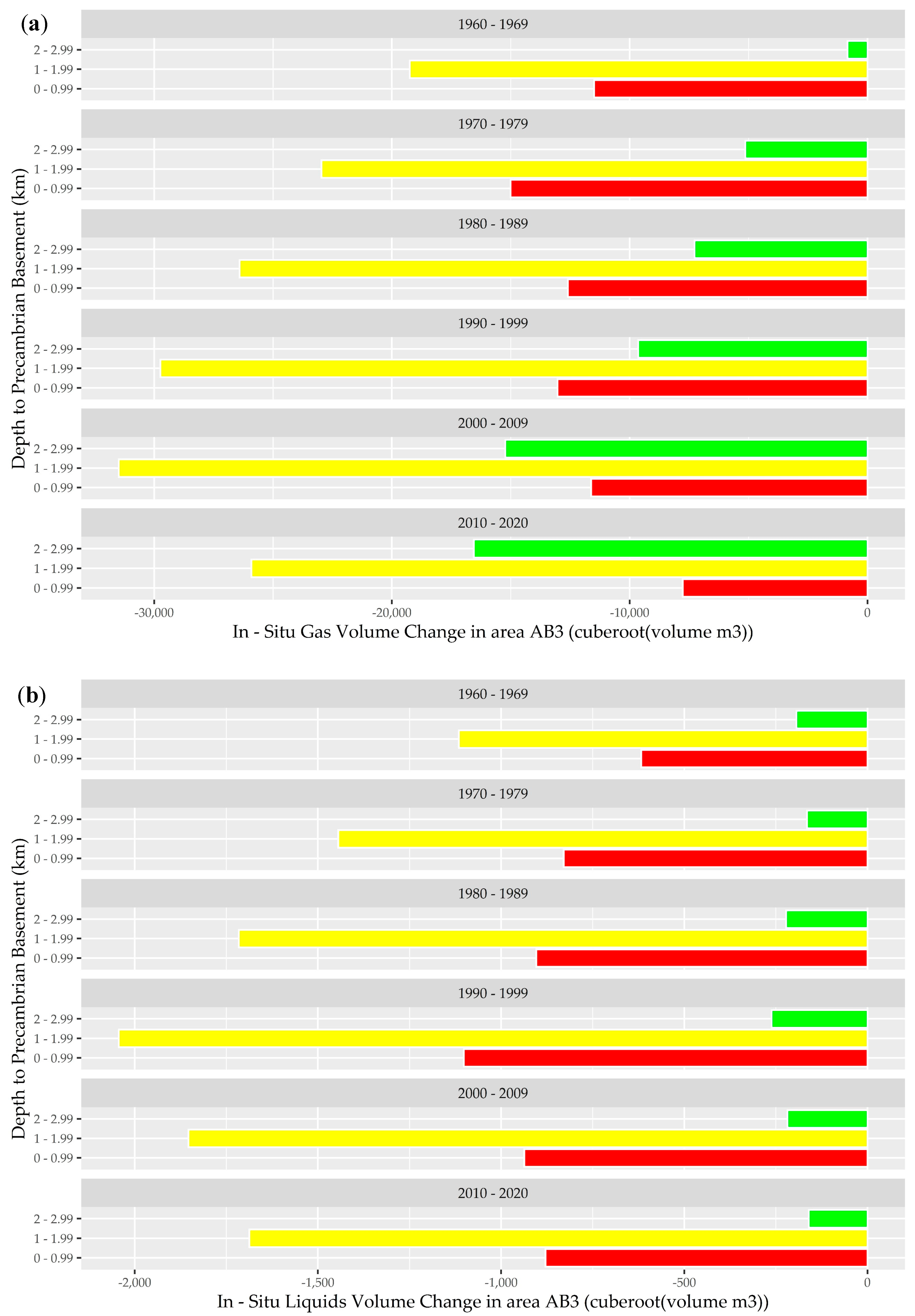


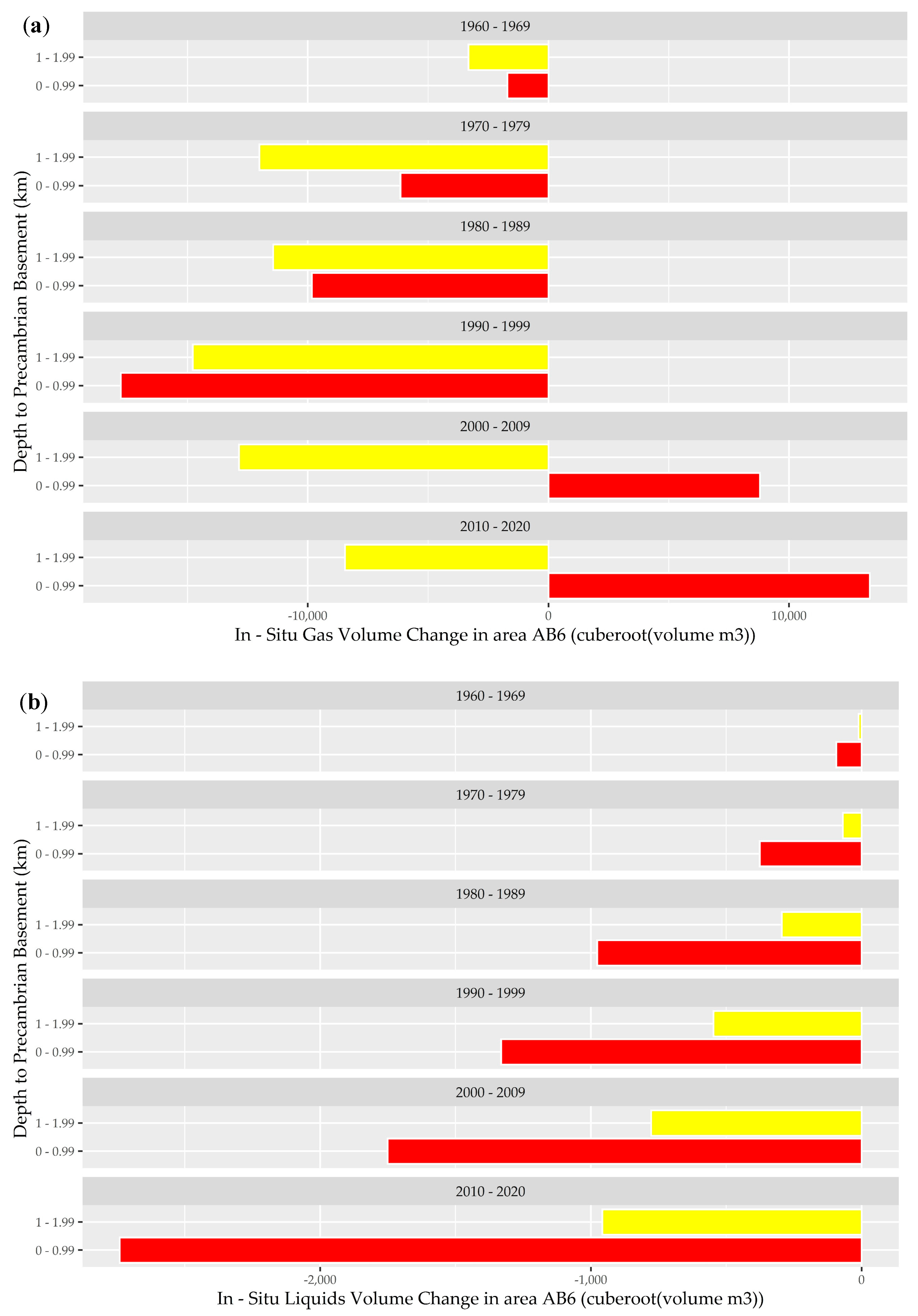
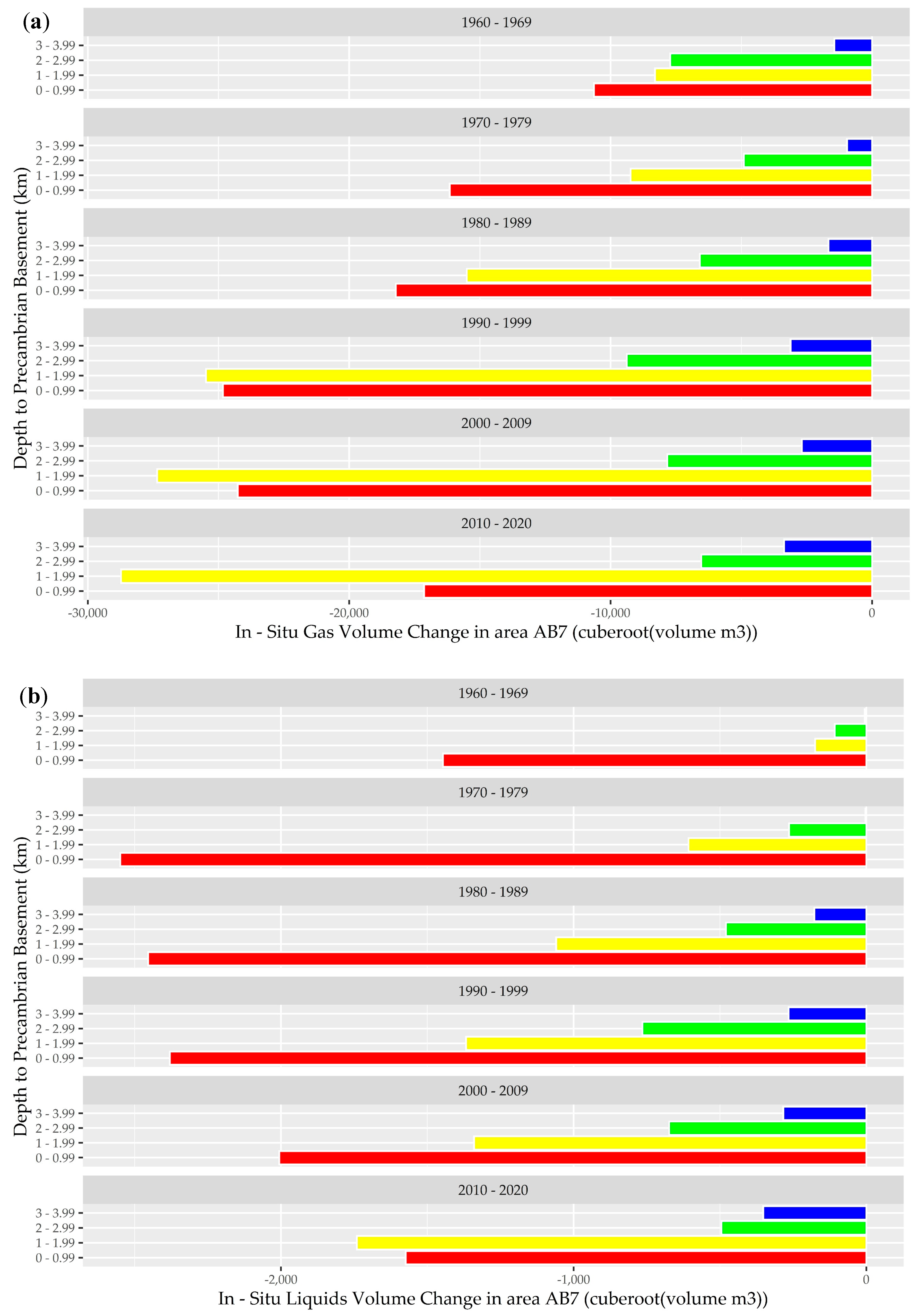

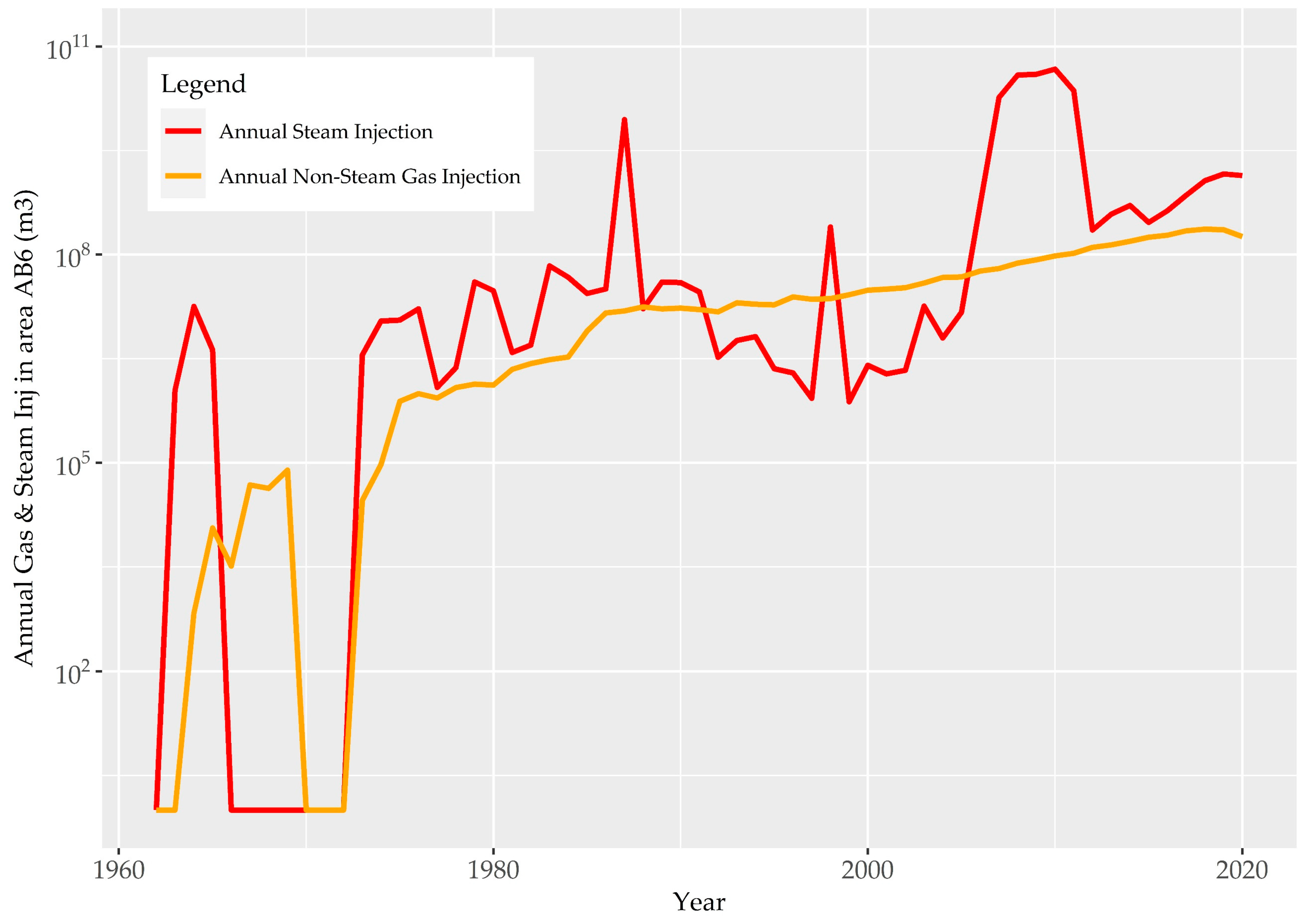

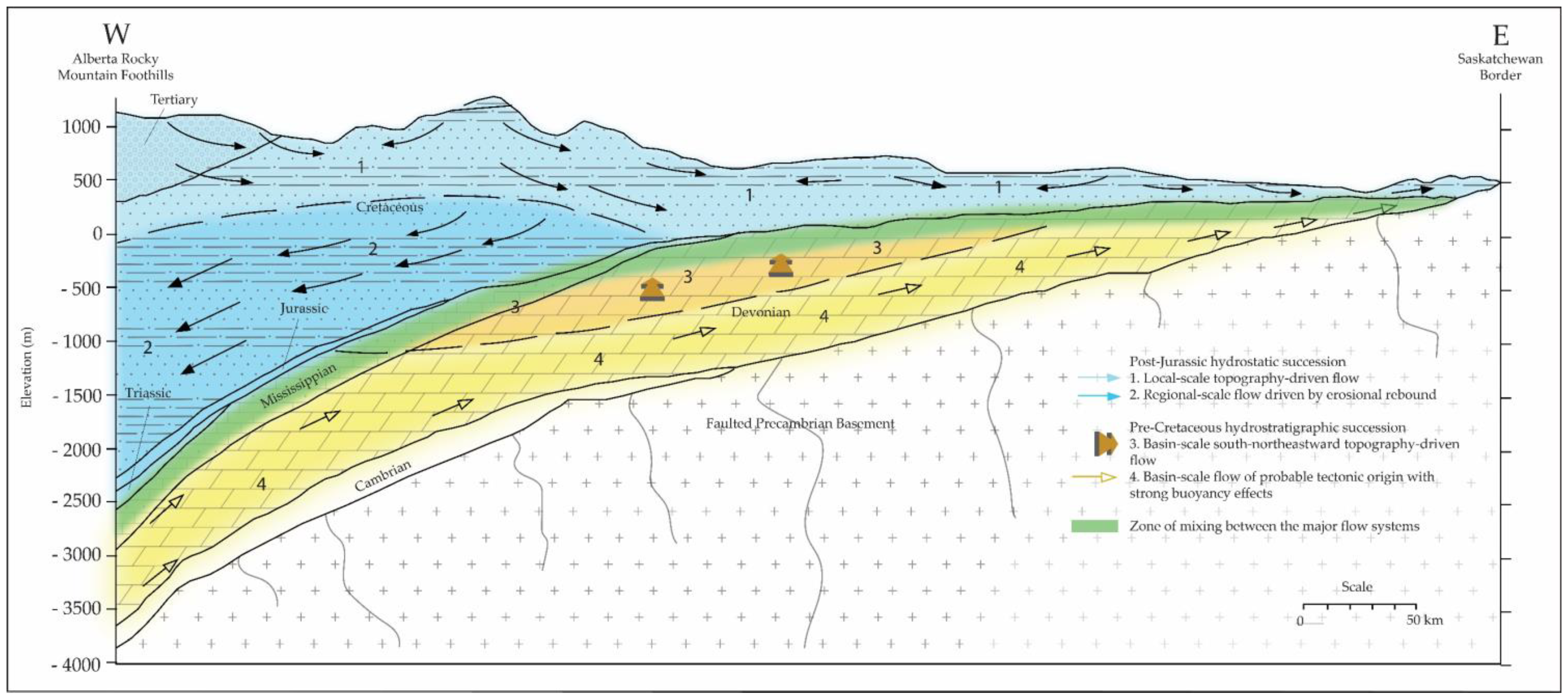
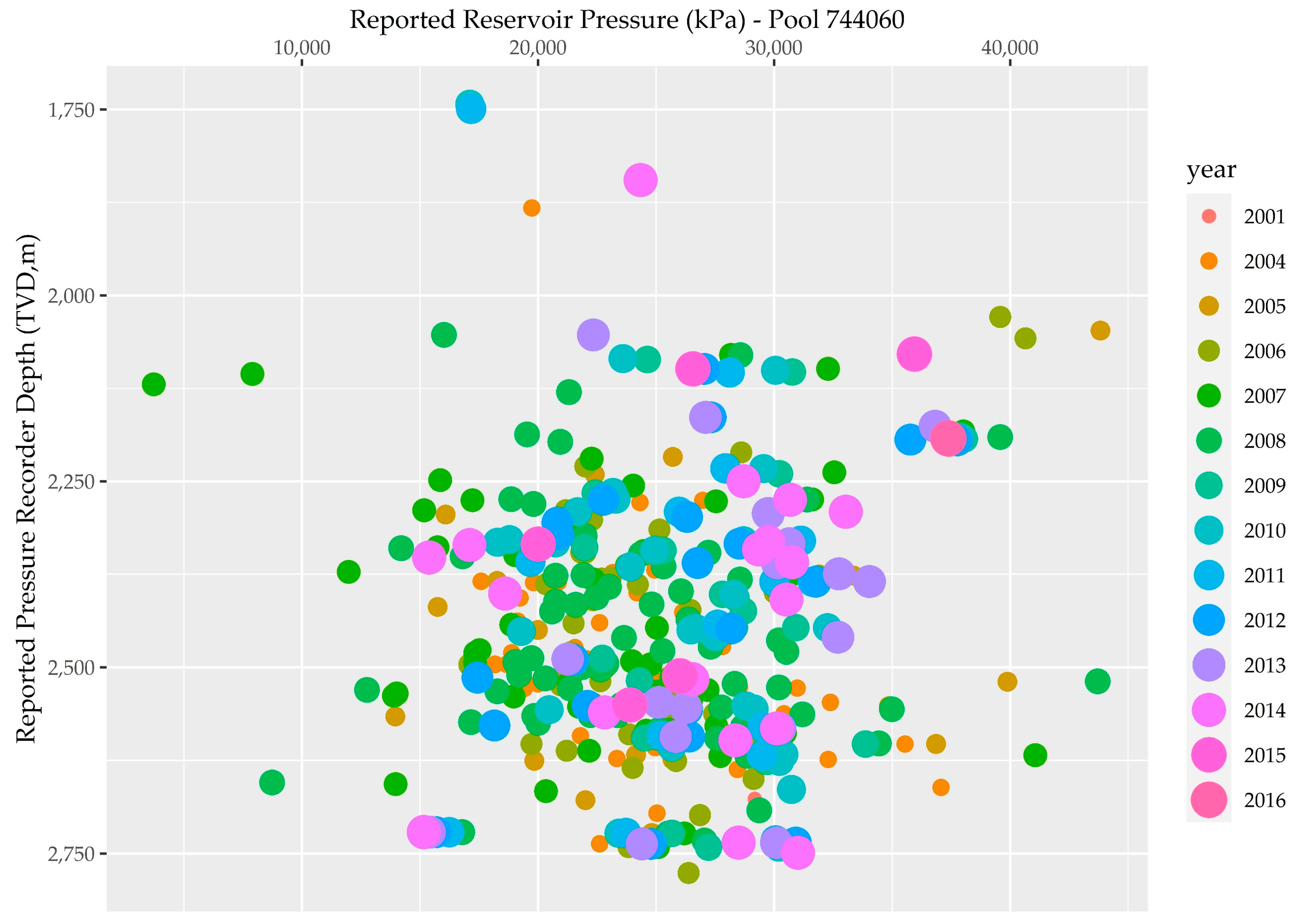
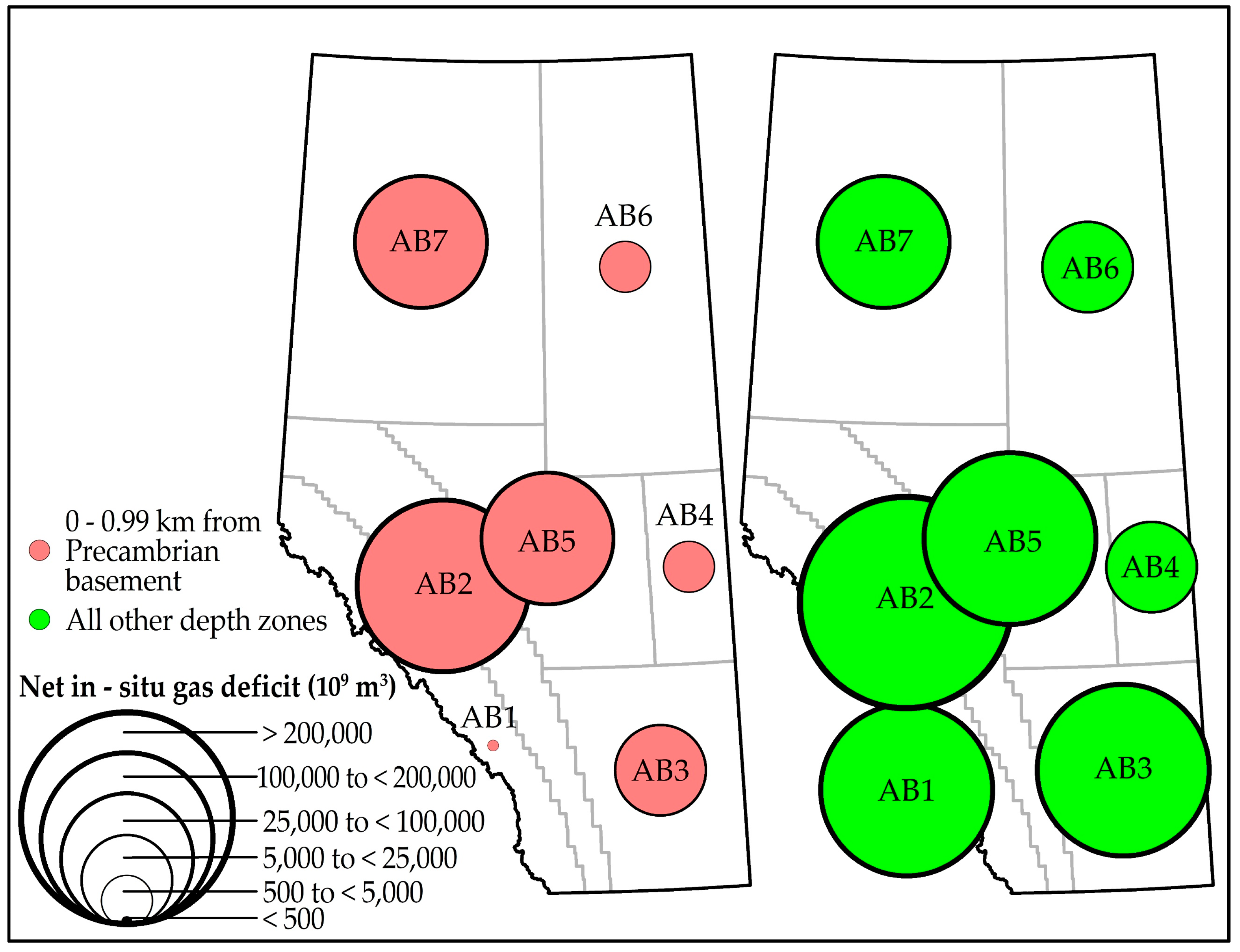
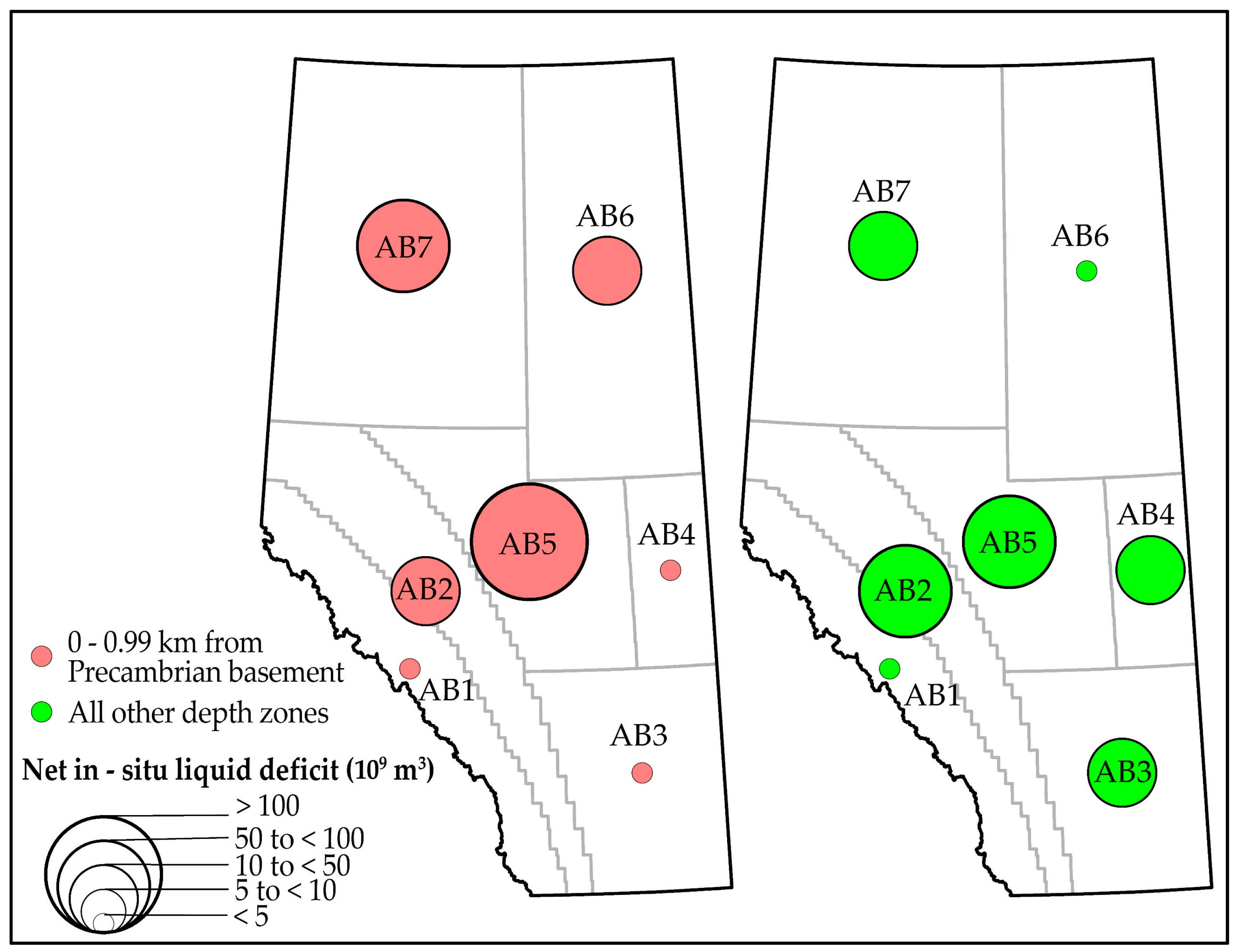
| Gases (m3) | Liquids (m3) | |
|---|---|---|
| Total produced | 6.84 × 1012 | 2.46 × 1010 |
| Total injected | 7.97 × 1011 | 2.01 × 1010 |
| Difference | −6.05 × 1012 | −4.53 × 1009 |
| Decade | Net Gas (m3) | Net Liquid (m3) |
|---|---|---|
| 1960–1969 | −3.82 × 1011 | −3.03 × 1008 |
| 1970–1979 | −7.18 × 1011 | −3.96 × 1007 |
| 1980–1989 | −8.34 × 1011 | −1.82 × 1008 |
| 1990–1999 | −1.38 × 1012 | −4.24 × 1008 |
| 2000–2009 | −1.47 × 1012 | −7.93 × 1008 |
| 2010–2019 | −1.16 × 1012 | −2.50 × 1009 |
| Totals | −5.56 × 1012 | −3.94 × 1009 |
| Area | Distance from Precambrian Basement (m) | Number of Pools with Comparable Pressure Data | Percentage of Pools Showing Increased Reservoir Pressure (%) | Average Increase (%) | Percentage of Pools Showing Decreased Reservoir Pressure (%) | Average Decrease (%) |
|---|---|---|---|---|---|---|
| AB1 | 5+ | 7 | 14 | 15 | 86 | −46 |
| AB1 | 4–4.99 | 18 | 11 | 91 | 89 | −36 |
| AB1 | 3–3.99 | 36 | 28 | 22 | 72 | −49 |
| AB1 | 2–2.99 | 47 | 13 | 35 | 87 | −50 |
| AB1 | 1–1.99 | 3 | 33 | 21 | 67 | −42 |
| AB1 | 0–0.99 | 1 | 0 | 0 | 100 | −66 |
| AB2 | 5+ | 1 | 0 | 0 | 100 | −20 |
| AB2 | 4–4.99 | 23 | 13 | 19 | 87 | −51 |
| AB2 | 3–3.99 | 79 | 15 | 80 | 85 | −44 |
| AB2 | 2–2.99 | 323 | 24 | 95 | 76 | −52 |
| AB2 | 1–1.99 | 996 | 22 | 70 | 78 | −51 |
| AB2 | 0–0.99 | 110 | 18 | 58 | 82 | −46 |
| AB3 | 2–2.99 | 92 | 36 | 117 | 64 | −45 |
| AB3 | 1–1.99 | 1351 | 23 | 50 | 77 | −44 |
| AB3 | 0–0.99 | 36 | 31 | 78 | 69 | −28 |
| AB4 | 1–1.99 | 884 | 21 | 45 | 79 | −40 |
| AB4 | 0–0.99 | 11 | 0 | 0 | 100 | −68 |
| AB5 | 3–3.99 | 2 | 0 | 0 | 100 | −66 |
| AB5 | 2–2.99 | 114 | 33 | 128 | 67 | −45 |
| AB5 | 1–1.99 | 1288 | 26 | 75 | 74 | −42 |
| AB5 | 0–0.99 | 25 | 40 | 108 | 60 | −32 |
| AB6 | 1–1.99 | 232 | 22 | 57 | 78 | −39 |
| AB6 | 0–0.99 | 238 | 15 | 38 | 84 | −41 |
| AB7 | 3–3.99 | 13 | 31 | 72 | 69 | −39 |
| AB7 | 2–2.99 | 63 | 17 | 133 | 83 | −49 |
| AB7 | 1–1.99 | 506 | 24 | 62 | 76 | −42 |
| AB7 | 0–0.99 | 400 | 28 | 85 | 73 | −36 |
| Area | 0–0.99 from the Precambrian Basement | All Other Depth Zones | ||
|---|---|---|---|---|
| Net Gas Deficit (km3) | Net Liquid Deficit (km3) | Net Gas Deficit (km3) | Net Liquid Deficit (km3) | |
| AB1 | −324 | 0 | −117,144 | −5 |
| AB2 | −166,562 | −38 | −447,808 | −87 |
| AB3 | −11,165 | −4 | −122,121 | −29 |
| AB4 | −2820 | −4 | −20,713 | −22 |
| AB5 | −52,007 | −161 | −121,545 | −70 |
| AB6 | −3742 | −29 | −9225 | −2 |
| AB7 | −46,116 | −60 | −68,361 | −13 |
Publisher’s Note: MDPI stays neutral with regard to jurisdictional claims in published maps and institutional affiliations. |
© 2022 by the authors. Licensee MDPI, Basel, Switzerland. This article is an open access article distributed under the terms and conditions of the Creative Commons Attribution (CC BY) license (https://creativecommons.org/licenses/by/4.0/).
Share and Cite
Samaroo, M.; Chalaturnyk, R.; Dusseault, M.; Jackson, R.; Buhlmann, A.; Custers, H. An Assessment of the Net Fluid Balance in the Alberta Basin. Energies 2022, 15, 1081. https://doi.org/10.3390/en15031081
Samaroo M, Chalaturnyk R, Dusseault M, Jackson R, Buhlmann A, Custers H. An Assessment of the Net Fluid Balance in the Alberta Basin. Energies. 2022; 15(3):1081. https://doi.org/10.3390/en15031081
Chicago/Turabian StyleSamaroo, Mahendra, Rick Chalaturnyk, Maurice Dusseault, Richard Jackson, Arndt Buhlmann, and Hans Custers. 2022. "An Assessment of the Net Fluid Balance in the Alberta Basin" Energies 15, no. 3: 1081. https://doi.org/10.3390/en15031081
APA StyleSamaroo, M., Chalaturnyk, R., Dusseault, M., Jackson, R., Buhlmann, A., & Custers, H. (2022). An Assessment of the Net Fluid Balance in the Alberta Basin. Energies, 15(3), 1081. https://doi.org/10.3390/en15031081







